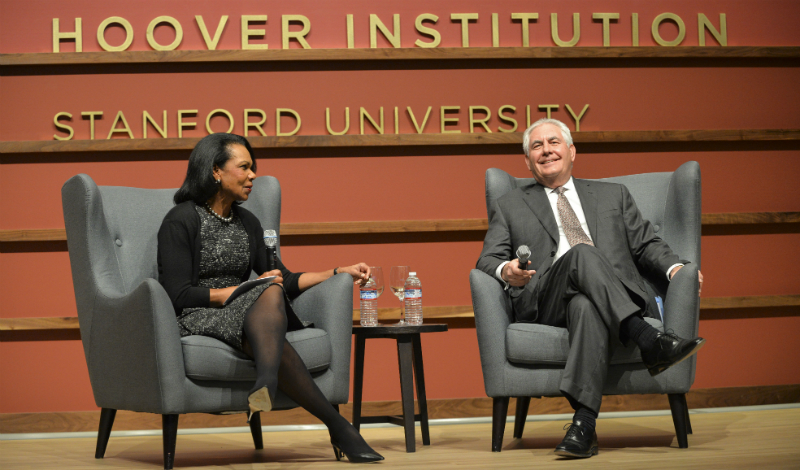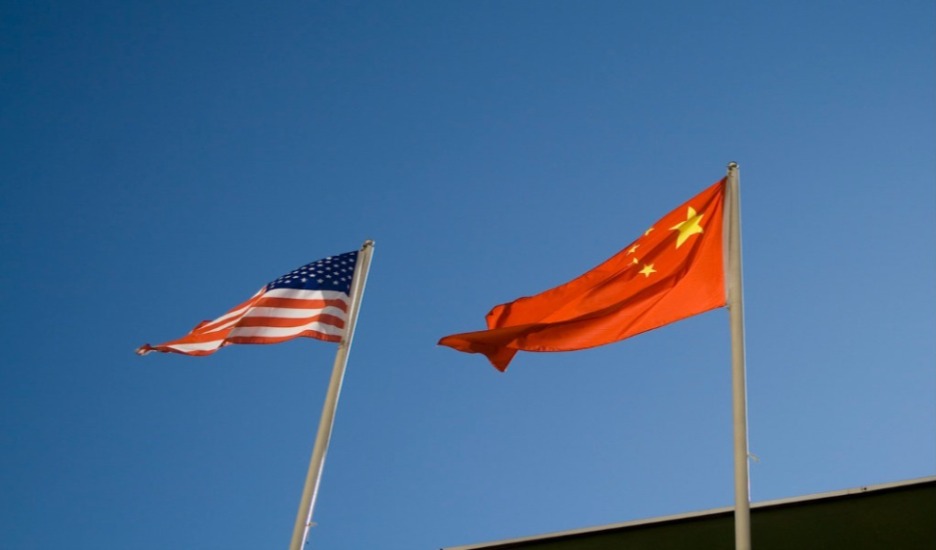Trump's New Syria Strategy is Woefully Unrealistic
On January 17, Secretary of State Rex Tillerson laid out the Trump administration’s Syria strategy for the first time at Stanford University’s Hoover Institute. Tillerson’s speech cleared up much of the uncertainty regarding whether the United States would stay in Syria after the defeat of the Islamic State, confirming that the administration would maintain a military presence in the country for the foreseeable future. In addition, he highlighted five key U.S.

Published by The Lawfare Institute
in Cooperation With

On January 17, Secretary of State Rex Tillerson laid out the Trump administration’s Syria strategy for the first time at Stanford University’s Hoover Institute. Tillerson’s speech cleared up much of the uncertainty regarding whether the United States would stay in Syria after the defeat of the Islamic State, confirming that the administration would maintain a military presence in the country for the foreseeable future. In addition, he highlighted five key U.S. objectives in Syria: ending the conflict through U.N.-backed negotiations resulting in the removal of Bashar al-Assad from power, completely defeating the Islamic State and al-Qaeda, creating conditions suitable for the return of refugees to Syria, rolling back Iranian influence, and finally securing the Syrian regime’s weapons of mass destruction (WMD).
To the Trump’s administration’s credit, these are admirable goals that are far removed from prior statements by Trump that suggested America would abandon Syria entirely. Nonetheless, much of the administration’s strategy is out of touch with the situation on the ground, and its objectives are far too lofty given the limited means the Trump administration is willing to employ to achieve them.
Since Russia’s intervention into the Syrian conflict in late 2015, the war has shifted from a stalemate between regime and opposition forces to a situation in which the Assad regime controls over half the country, most of the remaining population, and eight out of the ten largest cities. With the regime operating from a position of strength, backed by Russia and Iran, Assad’s removal through negotiations alone is improbable. Key regional actors such as Turkey and Iran have effectively abandoned the U.S.- and U.N.-backed negotiations in Geneva that the Trump administration supports, opting instead for parallel Russian-backed talks in Astana, Kazakhstan and Sochi, Russia. The administration could choose to proceed with the negotiations in Geneva nonetheless, but negotiations that do not seriously engage with the main actors in the conflict are unlikely to actually achieve anything.
On the other hand, the counterterrorism objectives mentioned in the speech are for more achievable, at least with regard to the Islamic State, as the United States has a credible counterterrorism partner on the ground in the form of the multiethnic Syrian Democratic Forces. Defeating al-Qaeda-linked Hayat Tahrir al-Sham would be far more challenging. The group has entrenched itself into rebel-held Idlib province in northern Syria, defeating or co-opting various more mainstream opposition forces. The United States currently lacks viable Syrian partners on the ground to support a fight against the group.
In addition to the conflict itself, the repercussions of the associated refugee crisis are far-reaching, contributing to the rise of right-wing political parties in Europe, furthering political instability in Lebanon, and severely stretching the resources of neighboring countries such as Turkey and Jordan. That is to say nothing of the human cost, as millions of Syrians have abandoned their homes and livelihoods due to indiscriminate bombing and political violence. Creating conditions conducive to the voluntary return of refugees to Syria would reduce instability throughout much of the Middle East.
However, it is not enough to simply secure territory for refugees to return. Syria’s economy has been devastated by years of indiscriminate warfare, amounting to more than $226 billion in lost GDP since 2011. More than a quarter of all housing units and about half of the country’s medical sector have been destroyed or damaged by fighting. Previously uncommon diseases and afflictions, such as Polio and the flesh-eating Leishmaniasis parasite, have spread throughout the country due to poorly maintained or damaged sewage and water systems. To achieve the Trump administration’s goal, the United States would have to bankroll the reconstruction of the country, help create inclusive governance structures across all of Syria, not just the northeast, and ensure safety for returning refugees—the very nation-building that President Trump has refused to support.
The administration’s Syria strategy also calls for ridding Syria of WMDs. The majority of the Assad regime’s WMDs, consisting of chemical weapons such as the highly toxic sarin and VX nerve agents, were destroyed according to an agreement between the United States, Russia, and the regime in 2013. Nonetheless, the regime maintained a small chemical weapons stockpile in secret, as shown by the Khan Sheikhoun sarin attack in April 2017, in which the regime bombed a rebel-held town with sarin, killing scores of civilians. The regime has also begun to regularly use chlorine gas bombs made from chlorine cylinders that were used before the war for industrial purposes; these improvised chemical weapons are a violation of the Chemical Weapons Convention—a treaty that Syria has signed. Securing and destroying the remaining stockpile could prove challenging to the Trump administration as, given its small size, it can be easily hidden in underground bunkers or warehouses. The complete destruction of all chemical weapons in Syria would likely require U.S. military personnel to search regime military facilities from top to bottom all across the country, something that is not feasible given the ongoing conflict.
During his presidential campaign, Trump promised to take a harsher stance against Iran while in office. This has played out in Tillerson’s speech: Diminishing Iran’s influence is a key plank of the overall strategy. Iran has played a destabilizing role in Syria, funneling a variety of foreign Shia militias, most notably Hezbollah, into Syria to prop up the decaying Syrian military on the battlefield. In addition to supplying funds, equipment, and manpower to the regime, Iran’s Islamic Revolutionary Guard Corps has created new proxy forces composed of Syrians rather than foreigners, further cementing Iran’s presence in the country.
It is unclear how the administration will roll back Iran’s influence in Syria. The most obvious method—putting pressure on the regime by backing the Syrian opposition—is no longer viable as very few opposition factions in Syria are both palatable to the United States and able to exert significant pressure on the regime and its allies. In any case, President Trump ended covert support to opposition forces in 2017, and even if the assistance program were restarted, the United States would face severe challenges as it tries to regain the trust of local partners.
In addition to broader concerns about Iranian influence, the administration views the possibility of Iran creating a land bridge through Iraq and Syria to Lebanon as a significant threat. In the administration’s view, such a bridge could be used by Iran to truck arms and fighters to Hezbollah in Lebanon. This would allow Iran to resupply Hezbollah directly by land, instead of by air or sea—a concern for U.S. ally Israel. To prevent Iran from establishing such a land route, the United States would have to secure the Syria-Iraq border, but the Syrian regime already controls the Abu Kamal border crossing with Iraq. The United States would have to clear these forces out of the crossing and the surrounding desert, an operation that would certainly involve U.S. military personnel in a direct confrontation with the regime.
While the United States does have a 2,000-troop strong military presence in Syria, this force is far too small to deter Iranian operations or secure the Syria-Iraq border. By one estimate, Iran, on top of a 3,000-strong Revolutionary Guard detachment, controls 79,000 fighters in Syria through various Lebanese, Afghan, Pakistani, Syrian, and Iraqi proxies. Barring a drastic escalation of military force against the regime—which may require congressional approval—clearing Iranian proxies from the Syria-Iraq border and disrupting Iranian operations elsewhere in Syria is unlikely to be achievable. Directly singling out Iran, without being able to wage an effective campaign against their proxies, may put American troops in the region at risk, as Iran could choose to strike at U.S. forces covertly in response. This is a particular danger in Iraq, where American troops and Iranian-backed Shia militias often operate in close proximity.
Declaring such goals publicly—in a speech no doubt watched by both America’s allies and foes—while not being able to credibly act to achieve them in any meaningful sense damages the United States and the Trump administration’s credibility abroad. Indeed, members of Trump’s cabinet have already backpedaled on some of the strategy. U.S. Secretary of Defense James Mattis noted in a press briefing a few days after Tillerson’s speech that the United States was actually drawing down its troop presence in Syria. Mattis even directly contradicted Tillerson, saying that U.S. forces were not in Syria for the long term, making it unclear whether the Trump administration is actually committed to its own Syria strategy.
Instead of setting overly-ambitious goals and under-delivering, the Trump administration should dial back their expectations for what the United States can achieve. Recognizing that the removal of Assad from power is unlikely in the foreseeable future may pave the way for more realistic negotiations over the future of Syria. A more pragmatic approach could allow the United States to abandon the moribund Geneva process and instead push for more inclusive direct talks between the Syrian Kurds and the regime, as former National Security Council directors Alexander Bick and Lisa Roman recently argued in Foreign Policy. A new, more modest Syria strategy that recognizes the limits of what American power can achieve will be more successful than Trump’s starry-eyed plan.


.jpg?sfvrsn=5a43131e_7)


